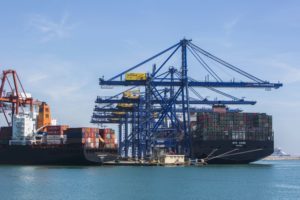
The VCFI stands at 4,653.85 points, accumulating a growth of 375.13% since the beginning of the historical series
Maritime transport continues to be affected by fuel prices, congestion in port areas and the geopolitical situation
The Western Mediterranean sub-index increases by 6.67%, while the Far East slows slightly and falls by 0.15%
Port congestion totalled 3.32M TEUs, representing 12.4% of the total fleet
València, June 3rd, 2022.- The Valencia Containerised Freight Index (VCFI) for the month of May has increased by 2.09% compared to the previous month, standing at 4,751.27 points. Thus, it accumulates a growth of 375.13% since the beginning of the series in 2018. The activity of the maritime sector is being conditioned by the high levels of uncertainty in the global economic situation that affect the balance between supply and demand for maritime transport. Maritime transport continues to be affected by fuel prices, congestion in port areas and the geopolitical situation.
In this regard, three months after the outbreak of the conflict in Ukraine, the energy and raw materials markets, both national and international, continue to be subject to the greatest supply and price tensions in recent decades, joining, even more strongly, the escalation of energy prices that has been imposed since 2021.
Thus, during May, the average price of a barrel of Brent crude oil was $112.73, compared with $104.58 the previous month, which represents an increase of 7.79% and a cumulative annual growth of 64.5%. As far as marine fuels are concerned, after a month of April where there seemed to be a certain containment, during May prices have again fluctuated upwards. According to data provided by Ship&Bunker, which takes the bunkering price of the 20 main ports in the world as a reference, the price of VLSFO (Very Low Sulphur Fuel Oil) has risen from 924.50$ in April to 1023.50$ in May, which means an increase of 10.7%.
In terms of capacity on offer, the Alphaliner consultancy reports that the commercially idle fleet has grown recently. Thus, in mid-May, 62 vessels were idle, with a total of 271,675 TEU, representing 1.1% of the total active fleet. The percentage of idle vessels is still low, however, it is higher than the data for 2021.
On the demand side, the RWI/ISL Container Througput Index reports a significant decline in port traffic volumes compared to the previous month due to the drop in Shanghai traffic as a result of the zero COVID-19 policy during May. In addition, Linerlytica points to a change in consumption patterns in North America, where, although import demand remains high, there are signs of a certain slowdown due to the increase in inventory levels, as well as the rise in private consumption of services to the detriment of spending on goods. At the same time, the impact on European port traffic due to the sanctions packages against Russia, as well as the fall in confidence levels and thus in consumption, are also highlighted.
Regarding congestion, the latest data provided by Linerlytica shows that in mid-May it totalled 3.32 million TEUs, representing 12.4% of the total fleet. The main areas affected by congestion include North Asia (34%), North America (26%) and Northern Europe (11%).
On this aspect, and in comparison with the previous month, it should be noted that the Chinese ports have overtaken the North American ports. To this effect, the ports of Los Angeles and Long Beach have notably improved their levels of tension, going from waiting times of 20 days at the beginning of the year to eight days in the middle of May. In Europe, the situation has also improved slightly, although it is still worrying, especially in the ports of Bremen, Hamburg and Rotterdam.
As regards the analysis of the different areas that make up the VCFI, the increase continues to be the general trend, with the exception of the Indian Subcontinent (-3.97%) and the Far East (-0.15%). Noteworthy is the increase in East Coast Africa freight rates (8.41%) as a direct consequence of the floods that took place last April, which continue to block the accesses to the Port of Durban, accumulating large quantities of containers and forcing port activity to come to a standstill. The freight levels of Atlantic Europe also rise (8.29%) because of the geopolitical conflict, as well as the high levels of congestion already mentioned.
VCFI Western Mediterranean
As for the Western Mediterranean sub-index, it shows an increase of 6.67% over the previous month, standing at 2,489.54 points, and accumulating a growth of 148.95% since the beginning of the series in 2018. At the same time, and although Valenciaport’s main container market is the Mediterranean-Black Sea, a decline has been reported in traffics going to Morocco, Tunisia and Algeria, with respect to the previous financial year.
VCFI Far East
In the Far East area, the Index has fallen by 0.15%, standing at 3,776.28 points and accumulating a growth of 276.63% with respect to the start of the series in January 2018. Valenciaport’s export flows with the Far East have fallen, especially with China (-6.95%), its main trading partner. Again, this is a one-off situation due to the closure of the port of Shanghai due to the outbreak of COVID-19. However, it is expected that the situation will be reversed with the lifting of the restrictions.
To read the full report, please click here.

